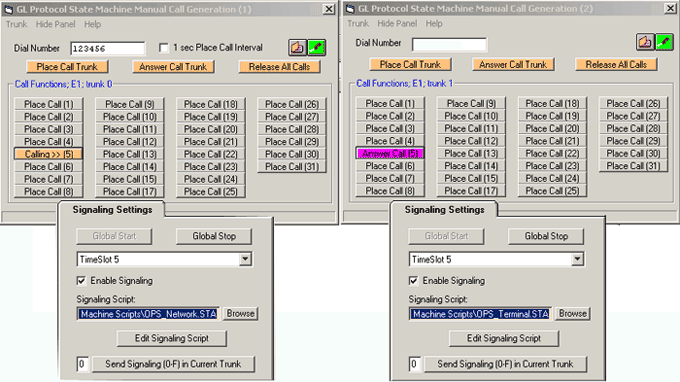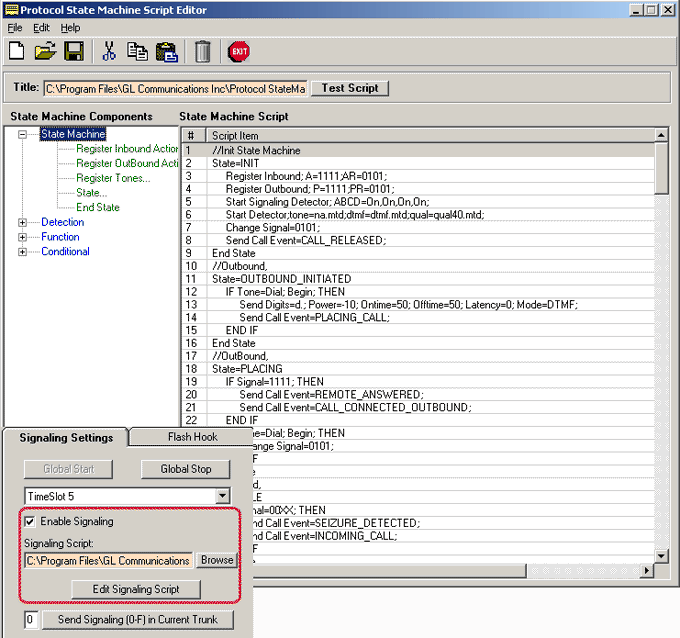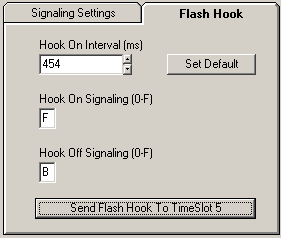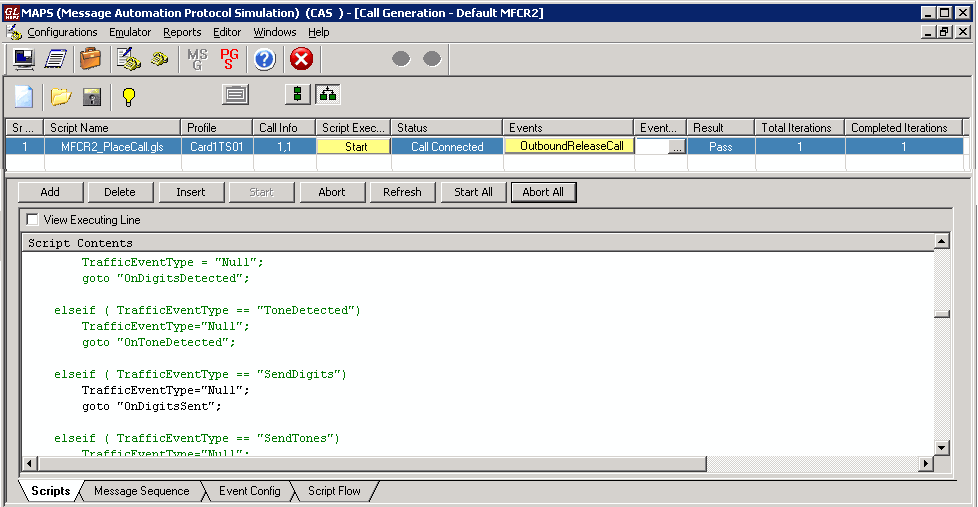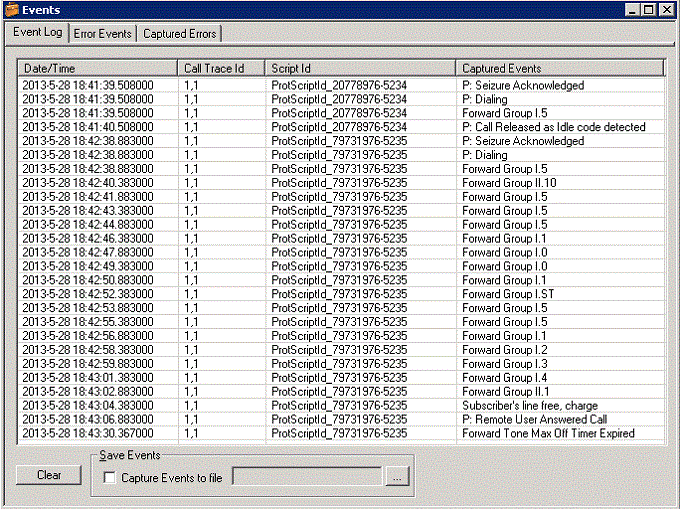Channel Associated Signaling Simulator (CAS Simulator)
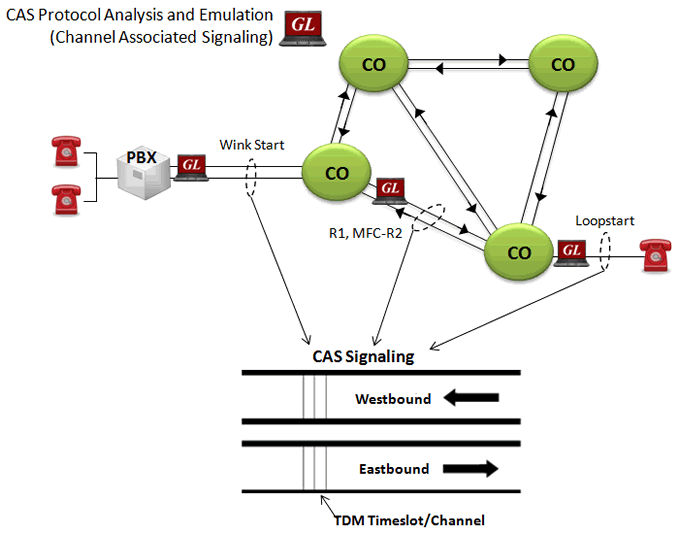
Overview
Channel Associated Signaling (CAS) is a method of signaling in telephone networks where each channel or timeslot carrying speech also carries with it the signaling and addressing to set up and tear down that same channel. This is referred to as "in-band" signaling. Various types of CAS signaling types include Loopstart, Groundstart, Feature Group D (FGD), Winkstart, E1 MFCR2, and others.
GL's Channel Associated Signaling (CAS) simulator is a client-side application that works along with the GL's T1/E1 Analyzer Cards and Windows Client/Server software. It is an optional application that simulates and analyzes any user-defined CAS protocols by providing signaling bit transitions and forward/backward frequency digits and tones. In order to easily create the user-defined CAS scripts, the CAS simulator includes a script editor. Multiple user-defined protocols may be defined for each of the digital T1/E1 trunks associated with the GL analysis boards. In addition to generating/receiving CAS calls, the CAS simulator also processes the receipt of Dialed Number Identification Service (DNIS) and Automatic Number Identification (ANI) information.
CAS emulation is also available with GL's Message Automation and Protocol Simulation (MAPS™). MAPS™ is a multi-protocol, multi-technology platform used for the emulation of a variety of communication protocols over IP, TDM, and Wireless networks. MAPS™ CAS can automate the testing procedure allowing the users to establish calls, and send/receive TDM traffic such as DTMF/MF digits, Tones, Fax, and Voice.
In addition, GL supports various E1 MFCR2 analysis and simulation solutions. For more information, visit MFC-R2 Analysis and Emulation webpage.
Supported Protocols
- E1 MFC-R2 (All variants, fully/semi compelled)
- E1 European Digital CAS (EUC), Digital E & M, International Wink Start
- E1 AP2 (Australian P2 protocol)
- T1 Winkstart (R1 wink)
- T1 Loopstart, Groundstart, Immediate Start, Feature Group D
- Any User-Defined CAS Protocol
Main Features
- Accesses the T1 (or E1) analyzer remotely
- Supports called number and calling number identification
- Customized signaling for each channel through scripts
- Ready-to-use scripts for quick testing
Call Generation/Reception with Signaling Status
In addition to receiving and placing calls, CAS Simulator also processes the receipt of Dialed Number Identification Service (DNIS) and automatic number identification (ANI) information, which is used to support authentication and other functions. The screenshots to the right display the manual call generation, and number identification functions performed by GL's CAS Simulator.
Script Editor
The GL CAS Simulator script is based on a self-describable language that can define the behavior of CAS Call Control procedure. Functions such as Place Call, Answer Call, Incoming Call, Disconnect call are all defined within the script. Additionally more advanced script may also be defined in the script. Definitions for Signaling Bit Transitions and forward/backward digits/tones are user definable within each script.
Capture Events
The events screen chronologically lists all of the CAS State Machine signaling bit transitions generated by each timeslot of each trunks. These transitions can be directed to an ASCII file is real-time or after they have appeared in the events list.
Flash Hook
The application also provides a way for the users to send a Flash Hook signal in line manually. Users can vary Flash Hook On Signal (0-F), Flash Hook Off Signal (0-F) and Flash Hook Interval (ms) for a given timeslot.
MFC-R2 Analysis and Emulation
GL's MFCR2 Analysis & Emulation solutions use any of the following hardware:
- T1E1 Analyzer (Potable USB or Ultra HD PCI cards or Universal Cards) Or
- DCOSS (Digital Central Office Switch Simulator)
Both the products supports remote capture & analysis using client-server technology, while DCOSS is ideal for simulating and testing advanced telecom networks and products, including switches, gateways, and transmission systems.
Visit MFC-R2 Analysis and Emulation webpage for details.
MAPS™ CAS Emulator
MAPS™ CAS Emulator automates the testing procedure allowing the users to establish calls, and send/receive TDM traffic such as DTMF/MF digits, Tones, Fax, and Voice.
Supports testing of various protocols such as T1 Wink Start (R1 wink), T1 Loop Start and T1 Ground Start, T1 Feature Group D, T1 Immediate Start, E1 MFC-R2 (All variants, full /semi compelled), E1 European Digital CAS (EUC), E1 Digital E & M, E1 International Wink Start, and Any User-Defined CAS Protocol.
E1 MFC-R2 Signaling defined by the ITU Recommendations Q.421-Q.442, uses a multi-frequency compelled signaling protocol to exchange address information. MAPS™ CAS Emulator generates and sends MFC-R2 forward and backward tones per CCITT specifications. Currently, MAPS™ CAS includes ready profiles for India, China, and Mexico. Different country specific implementations will be supported in future.
Visit MAPS™ CAS Protocol Emulator webpage for details.
Resources
Note: PCs which include GL hardware/software require Intel or AMD processors for compliance.
Please Note: The XX in the Item No. refers to the hardware platform, listed at the bottom of the Buyer's Guide, which the software will be running on. Therefore, XX can either be ETA or EEA (Octal/Quad Boards), PTA or PEA (tProbe Units), XUT or XUE (Dual PCIe Express) depending upon the hardware.
| Item No. | Item Description |
| XX625 | CAS Simulator |
| XX610 | w/ Transmit and Receive File Capability |
| XX620 | w/ DTMF/MF/MFC-R2 + answer/place call capability |
| XX630 | DSP Functionality |
| Related Software | |
|---|---|
| XX651 | MAPS™ CAS Protocol Emulator |
| XX031 | Enhanced T1 / E1 Call Capture/Analysis Software |
| XX020 | File Record/Playback Software |
| XX051 | Synchronous Trunk Record Playback |
| PKV104 | FaxScan™ for SIP and Fax over IP (T.38) |
| Related Hardware | |
| FTE001 ETE001 |
QuadXpress T1E1 Main Board (Quad Port– requires additional licenses) OctalXpress T1E1 Main Board plus Daughter Board (Octal Port– requires additional licenses) |
| PTE001 | tProbe™ Dual T1 E1 Laptop Analyzer with Basic Analyzer Software |
| XTE001 |
Dual T1 E1 Express (PCIe) Boards (requires additional licenses) |
 Back to List of T1E1 Basic and Optional Applications Index Page
Back to List of T1E1 Basic and Optional Applications Index Page
